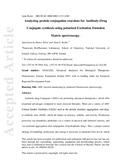| dc.contributor.author | de Faria e Silva, Ana L. | |
| dc.contributor.author | Ryder, Alan G. | |
| dc.date.accessioned | 2023-05-11T08:03:38Z | |
| dc.date.available | 2023-05-11T08:03:38Z | |
| dc.date.issued | 2022-09-07 | |
| dc.identifier.citation | de Faria e Silva, Ana L., & Ryder, Alan G. (2022). Analyzing protein conjugation reactions for antibody-drug conjugate synthesis using polarized excitation emission matrix spectroscopy. Biotechnology and Bioengineering, 119(12), 3432-3446. doi:https://doi.org/10.1002/bit.28229 | en_IE |
| dc.identifier.issn | 1097-0290 | |
| dc.identifier.uri | http://hdl.handle.net/10379/17769 | |
| dc.description.abstract | Antibody-drug conjugates (ADCs) are promising anticancer therapeutics, which offer important advantages compared to more classical therapies. There are a variety of ADC critical quality attributes (CQAs) such as the protein structure, aggregation, and drug-to-antibody ratio (DAR), which all impact on potency, stability, and toxicity. Production processes can destabilize antibodies via a variety of physical and chemical stresses, and or by increased aggregation after conjugation of hydrophobic drugs. Thus, a proper control strategy for handling, production, and storage is necessary to maintain CQA levels, which requires the use of in-process quality measurements to first identify, then understand, and control the variables which adversely affect ADC CQAs during manufacturing. Here, we show how polarized excitation emission matrix (pEEM) spectroscopy, a sensitive, nondestructive, and potentially fast technique, can be used for rapidly assessing aggregation and DAR in a single measurement. pEEM provides several sources of information for protein analysis: Rayleigh scatter for identifying aggregate/particle formation and fluorescence emission to assess chemical and structural changes induced by attachment of a linker and/or a small molecule drug payload. Here, we used a nontoxic ADC mimic (monoclonal antibody with linker molecule) to demonstrate efficacy of the measurement method. Emission changes caused via light absorption by the attached linker, allowed us to predict DAR with good accuracy using fluorescence signal from the final purified products (6% relative error of prediction [REP]) and also from unpurified alkylation intermediates (11% REP). pEEM changes could also be correlated with size (hydrodynamic radius, Rh) and aggregate content parameters obtained from dynamic light scattering and size exclusion chromatography (SEC). For the starting material and purified product samples, pEEM correlated better with Rh (R2¿=¿0.99, 6% REP) than SEC determined aggregate content (18% REP). Combining both fluorescence and light scatter signals also enabled in-process size quantification (6% REP). Overall, combining polarized measurements with EEM and Rayleigh scatter provides a single measurement, multi-attribute test method for ADC manufacturing. | en_IE |
| dc.description.sponsorship | This publication emanated from research supported in part by a Principal Investigator research grant (Grant Number 14/IA/2282) to Alan G. Ryder from Science Foundation Ireland and is cofunded under the European Regional Development Fund. 14/IA/2282, Advanced Analytics for Biological Therapeutic Manufacture, Science Foundation Ireland (SFI) with co-funding under the European Regional Development Fund. Open access funding provided by IReL. | en_IE |
| dc.format | application/pdf | en_IE |
| dc.language.iso | en | en_IE |
| dc.publisher | Wiley | en_IE |
| dc.relation.ispartof | Biotechnology and Bioengineering | en |
| dc.rights | Attribution 4.0 International (CC BY 4.0) | |
| dc.rights.uri | https://creativecommons.org/licenses/by/4.0/ | |
| dc.subject | antibody drug conjugate | en_IE |
| dc.subject | conjugation | en_IE |
| dc.subject | fluorescence | en_IE |
| dc.subject | monoclonal antibody | en_IE |
| dc.subject | polarized | en_IE |
| dc.title | Analyzing protein conjugation reactions for antibody-drug conjugate synthesis using polarized excitation emission matrix spectroscopy | en_IE |
| dc.type | Article | en_IE |
| dc.date.updated | 2023-05-10T10:58:44Z | |
| dc.identifier.doi | 10.1002/bit.28229 | |
| dc.local.publishedsource | https://doi.org/10.1002/bit.28229 | en_IE |
| dc.description.peer-reviewed | peer-reviewed | |
| dc.contributor.funder | Science Foundation Ireland | en_IE |
| dc.contributor.funder | European Regional Development Fund | en_IE |
| dc.internal.rssid | 29772165 | |
| dc.local.contact | Alan Ryder, School Of Chemistry, Room 213, Arts/Science Building, South Cam, Nui Galway. 2943 Email: alan.ryder@nuigalway.ie | |
| dc.local.copyrightchecked | No This is an open access publication...so not sure do we also host a copy on ARAN, | |
| dc.local.version | PUBLISHED | |
| dcterms.project | info:eu-repo/grantAgreement/SFI/SFI Investigator Programme/14/IA/2282/IE/Advanced Analytics for Biological Therapeutic Manufacture (AA-BTM)./ | en_IE |
| nui.item.downloads | 97 | |


